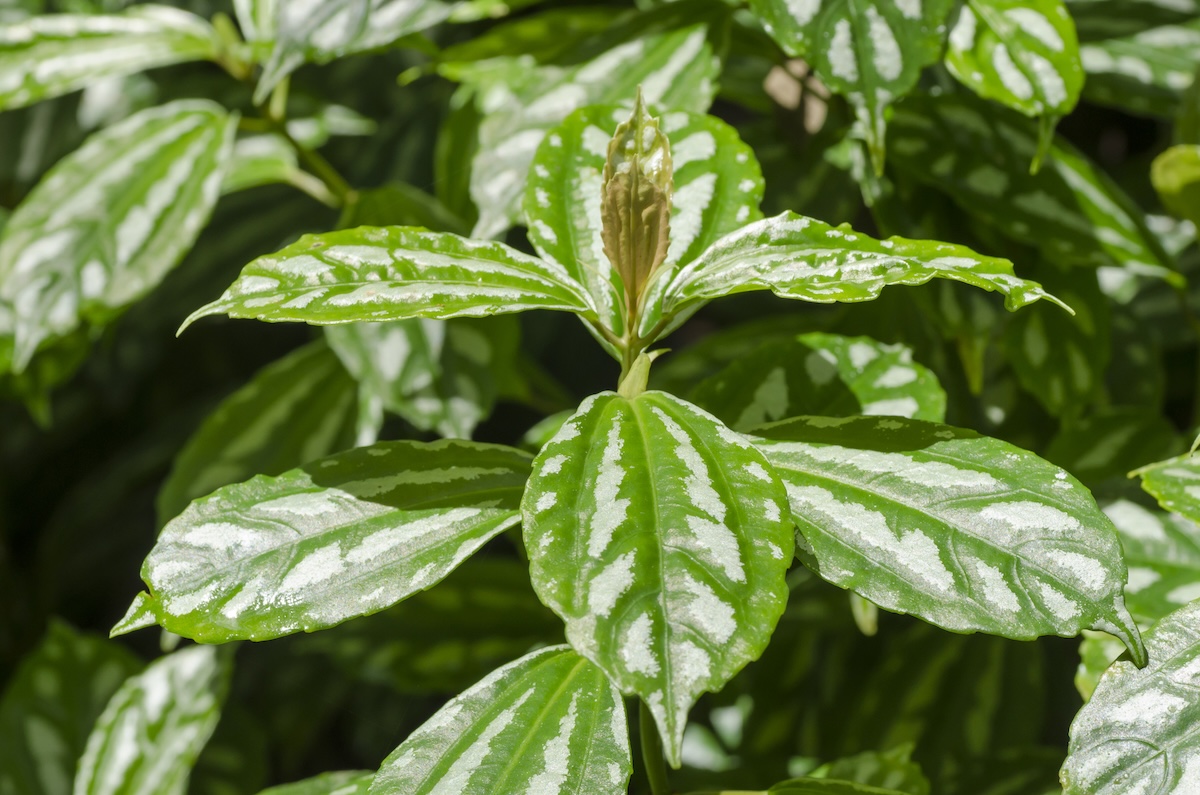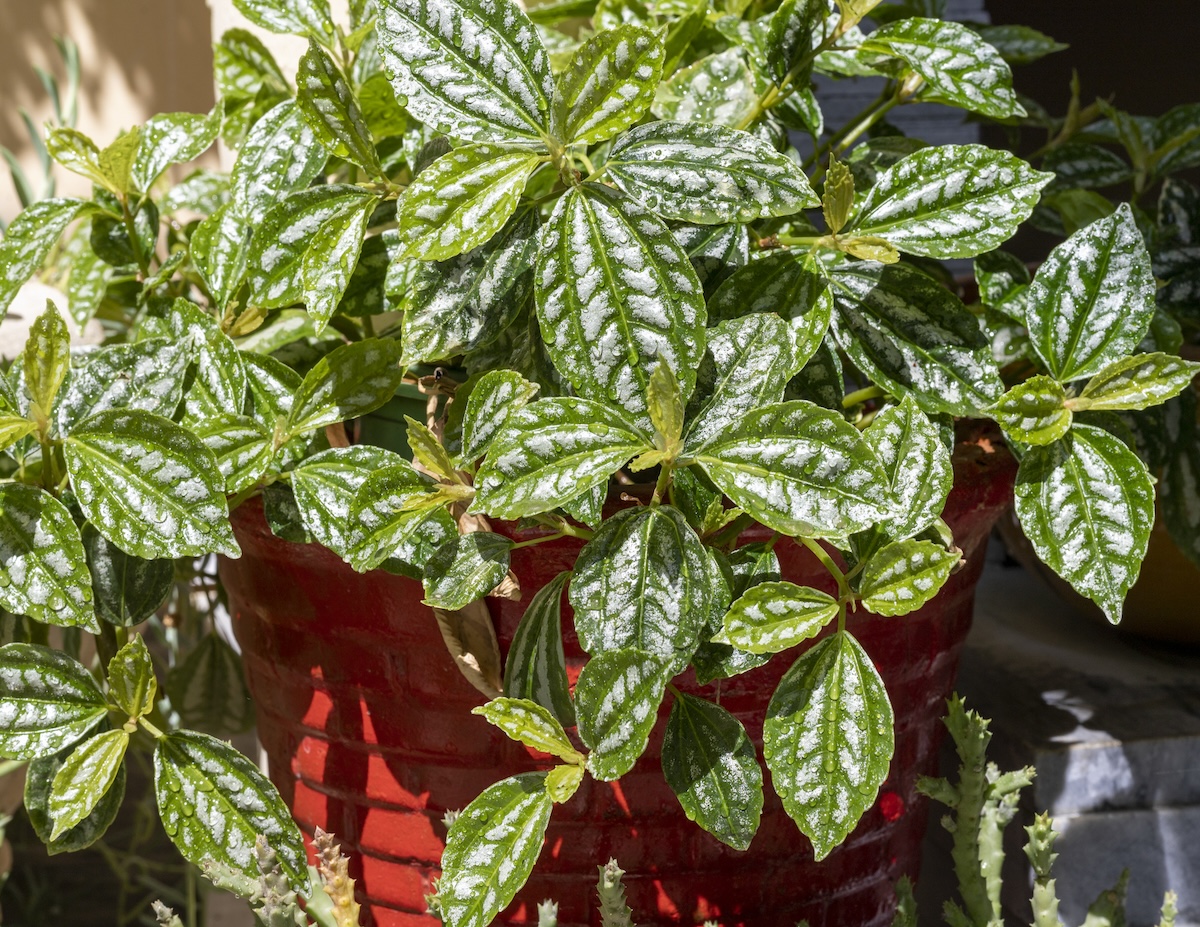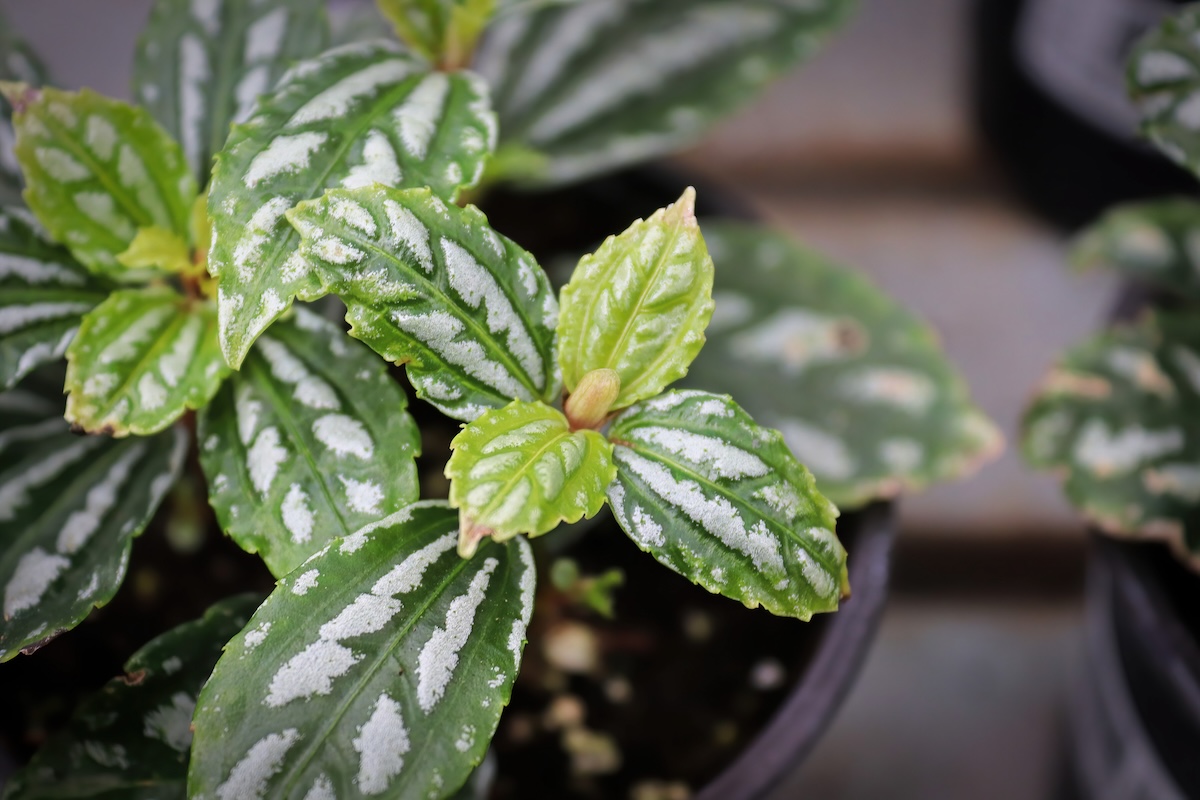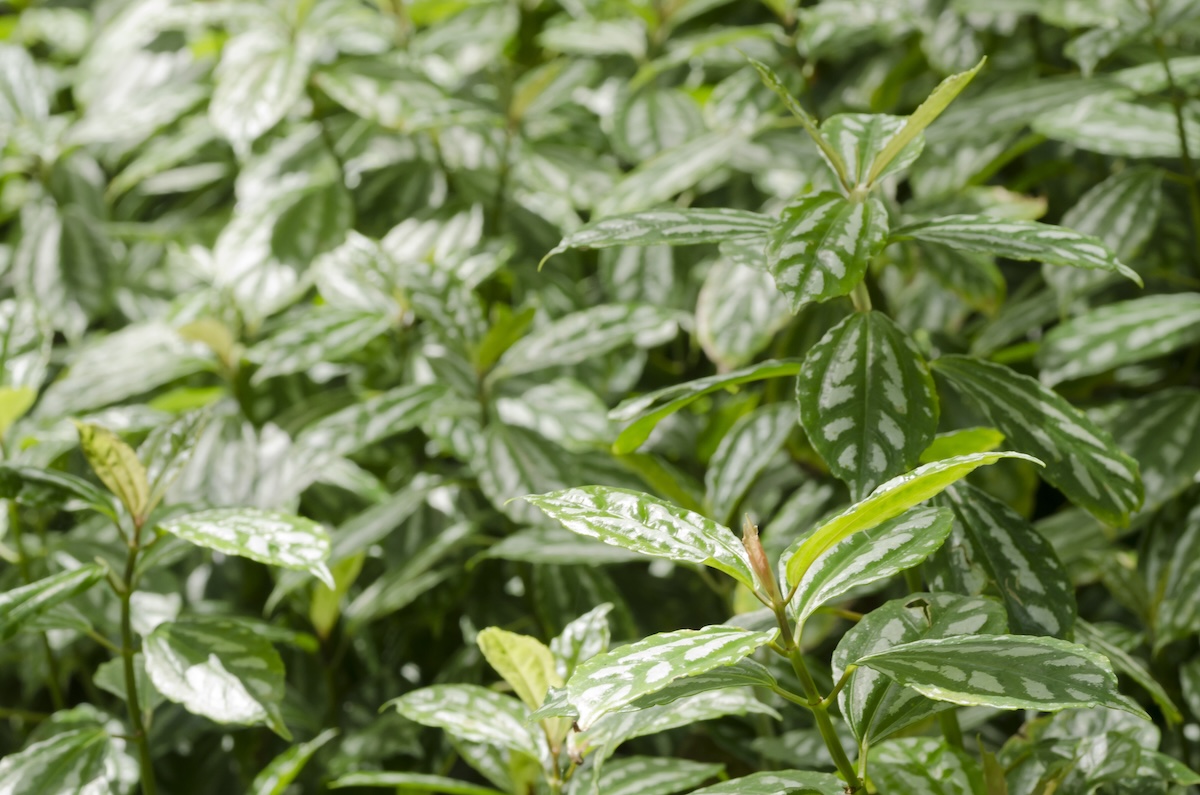

We may earn revenue from the products available on this page and participate in affiliate programs. Learn More ›
Although aluminum in plants isn’t a good thing because it suppresses nutrients, the aluminum-like glitter on the leaves of Pilea cadierei can be a very good thing for those who appreciate sparkliness. In The Complete Houseplant Survival Manual, author Barbara Pleasant notes “The most gifted artist would have difficulty creating a painting as beautiful as the leaves of aluminum plant.”
In The Indestructible Houseplant, author Tovah Martin agrees, writing that the species is “complaisant and colorful, with smallish shiny green leaves marked with mirror-like silver insets.” She notes that she has never experienced problems with aluminum plant care and that this pilea “has deep roots in houseplant traditions.”
Aluminum Plant Care at a Glance
Common Name: Aluminum plant or watermelon pilea
Scientific Name: Pilea cadierei or Pilea aluminum
Soil: Standard potting mix
Light: Bright, indirect
Water: Medium
Food: Balanced houseplant food
Temperature and Humidity: Typical household temperatures, high humidity
Propagation: Tip cuttings
Safety: Non-toxic
Aluminum Plant Characteristics

The variegated aluminum plant is named P. cadierei after plant hunter R. P. Cadiere, who (for Western botany) identified this member of the nettle family in Vietnam, though it is also native to a couple Chinese provinces. It typically stays 9 to 12 inches tall for a considerable time, but “then it can stretch to twice that size while the leaves gain length,” Martin notes
Those dark green leaves sport silver blotches between their veins, which explain why the plant is known to some as the watermelon pilea, due to its resemblance to the pattern on watermelon rinds. Pilea actually means “cap,” supposedly in reference to the plant’s cap of posies, but aluminum flowers actually are insignificant clusters of small greenish or pinkish-white blooms.
Hardy only in USDA zones 10 through 12 and sometimes grown as a shade-preferring ground cover in those zones, the plant will root wherever it comes in contact with the soil.
Types of Aluminum Plants
- Pilea cadierei: The classic aluminum plant, this one can reach heights of around 18 inches, with dark green leaves up to 4 inches in length and silver splotches between their veins.
- Pilea cadierei ‘Ellen’: Also called Silver Plated Pilea, ‘Ellen’ grows up to 12 inches tall with leaves that are entirely silver.
- Pilea cadierei ‘Minima’: A dwarf version of the classic aluminum plant, this cultivar usually doesn’t surpass a height of more than 6 inches.
Selecting Soil and Containers for Aluminum Plants
The best soil for pilea is a typical houseplant potting mix with a pH between 5 and 6, which includes plenty of peat and/or humus. African violet potting soil should suit Asian pileas, too.
Should you use aluminum planters for your aluminum plants? Although that might seem appropriate, any type of pot will do as long as it is one that doesn’t dry out rapidly since the plant prefers to be kept on the damp side. However, that container should include drainage holes, as this species is prone to root rot if kept too soggy.
The Right Light
Pilea lighting requirements specify that you should keep your plant out of direct sun, which can scorch its foliage, but still provide plenty of bright, indirect illumination for it. You can do that by placing it near an east or west facing window but back far enough that the sun’s rays don’t fall on it.
Alternatively, place a sheer curtain between the plant and the panes or set it near a frosted bathroom window, since that environment also should provide the humidity and indirect light that this plant prefers. When growing it as a groundcover, place it where it receives only dappled sun or shade.
Watering Aluminum Plants
When caring for Pilea cadierei, keep its potting mix lightly moist but never soggy. Discard any water that remains in the saucer after you have watered it to prevent that excess water from being absorbed.
If your plant stays wilted even when its soil is moist, you may have overwatered it over a long period of time, causing its roots to rot. Should you decide that the problem is root rot, you can try to propagate the plant via tip cuttings, as explained below, since the roots may not be salvageable.
Fertilizing Aluminum Plants

Feed your aluminum plant once a week in spring and summer with a balanced houseplant fertilizer applied at only half the recommended rates (since those rates usually are based on biweekly feeding). In autumn, apply that plant food only once per month and avoid feeding the plant at all during winter.
Aluminum plant brown tips can be due to overfertilization, which causes a buildup of salts in the soil. To alleviate that, remove the plant’s saucer and place its pot in an open sink. Pour water through the soil to clean it, until the excess trickles through the drainage holes and down the sink’s drainpipe. Allow the pot to drain completely before returning it to its saucer.
Setting the Temperature and Humidity
Brown tips can also be caused by low humidity, since the aluminum plant prefers high to moderate humidity. To provide more moisture in the air around your pilea, place it in a cluster of other plants, on top of a humidity tray, in a bathroom, or on a shelf over a sink.
The plant enjoys normal household temperatures between 60 to 75 degrees, though it reportedly will tolerate conditions down to 50 degrees. However, you should keep it away from doors or drafty windows during winter, because chilling will cause its leaves to brown and drop.
Propagating Aluminum Plants
To attempt aluminum plant propagation, you should snip 3- to 4-inch cuttings from the tips of its branches, making each cut just below a leaf node. Remove the lower leaves from each cutting, leaving only a couple leaves at the tip.
After dipping the bases of your cuttings in rooting powder or liquid, pot them up in a container filled with damp and sterile seed starting mix, covering the lowest node on each cutting with the mix. Place an inverted plastic bag, supported with plastic straws or small stakes, over the pot and set it in a warm location with bright, indirect light until the cuttings root, which should take about one month.
Safety Considerations

According to the ASPCA, the aluminum plant is considered non-toxic for both pets and livestock. Nebraska Extension also lists it under the houseplants that are non-toxic to humans, including toddlers, who are the only humans likely to try to eat it!
However, as Children’s of Alabama notes, even nontoxic plants “may be a choking hazard to small children.” So it is best, if possible, to keep all plants out of the reach of toddlers’ fingers—especially those that, like this one, bear some resemblance to a sweet treat like watermelon. (Fortunately, in this case the resemblance is not a strong one.)
Potential Pests and Diseases
As with many other plants that prefer moist conditions, this pilea may suffer from spider mites if kept too dry. Symptoms include too-pale leaves with what appear to be webs on their undersides. Before attempting to treat them, keep in mind that the aluminum plant doesn’t tolerate chemical pesticides well.
Therefore, Pleasant recommends that you first try removing the most damaged foliage and misting your plant every day for a week. If that doesn’t work, you may want to try insecticidal soap—following the directions on the package. Repeat the soap treatment every five days until the mites appear to be gone.
FAQ About Aluminum Plant Care
Although an aluminum plant sounds like a factory that makes recyclable cans, it actually can be a splashy, silvery houseplant, too. If you need in-depth information on yours, consult the article above. If you just would like some brief pointers on Pilea cadierei care, check out the questions and answers below.
Brown tips on aluminum plant foliage can be caused by either overfertilization or low humidity.
In USDA zones 10 through 12, aluminum plants can be grown outdoors in a shaded location.
Although aluminum plant cuttings sometimes are rooted in water, those roots are prone to rot if kept too wet for too long, so the plant will stay healthier if grown in soil instead.
Looking for more low-light plants? Check out our guides on caring for cast iron plant, peace plant, and snake plant.
